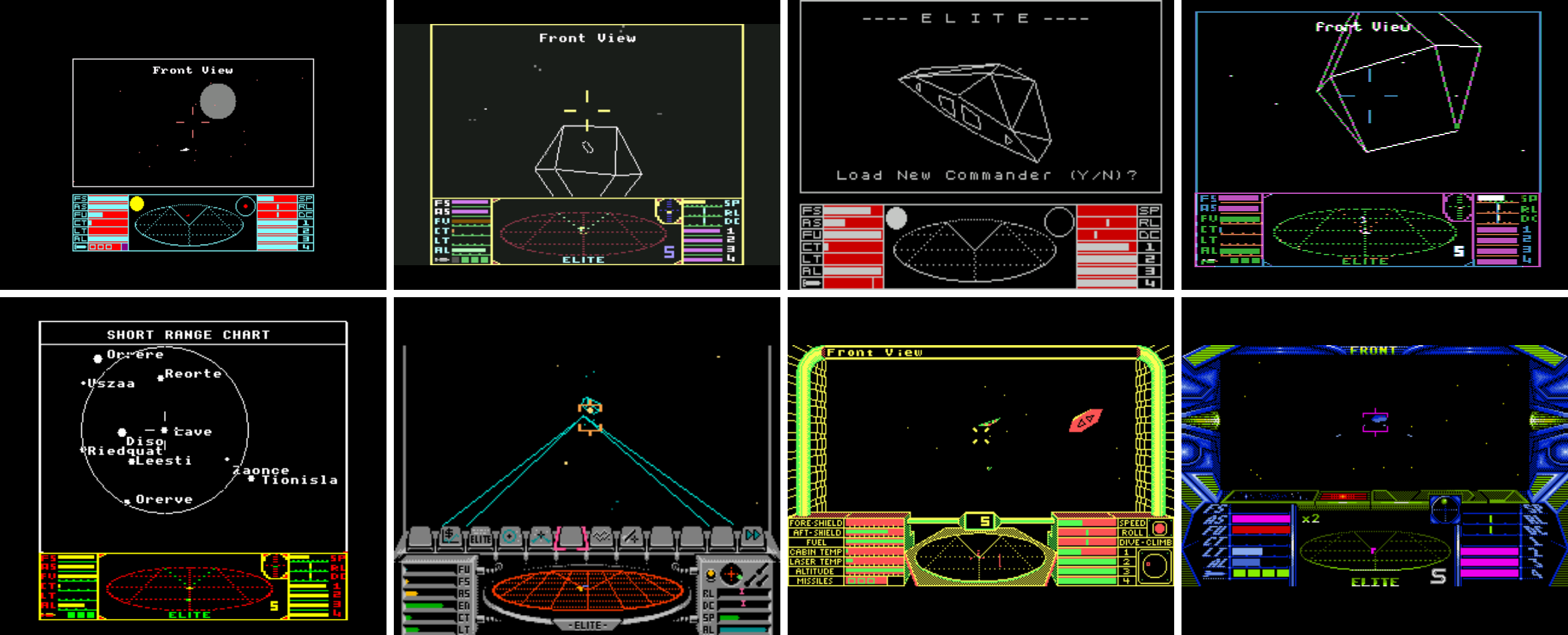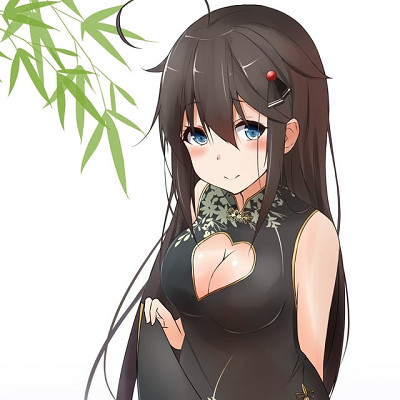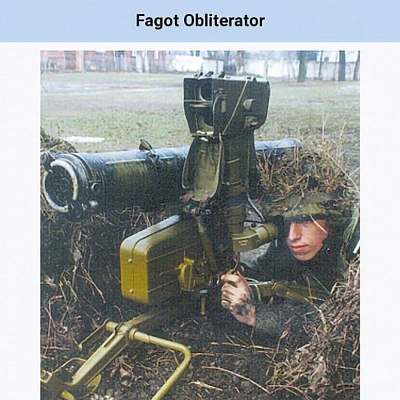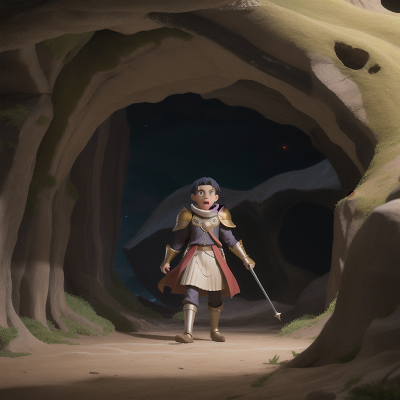Elite - Video Game From The Early 80's
4 years ago • 5,219 Views • 2 Files
Description
In the game the player can fly around the universe in his or her space ship. The player starts out with virtually no equipment and can trade goods between star systems to make a living. More money allows the player to buy better equipment. Meanwhile the player must be on the lookout for pirates.
Development
According to Braben and Bell, Elite was inspired by a range of sources. The developers refer to 2001: A Space Odyssey, Star Wars, Hitchhiker's Guide to the Galaxy and the original Battlestar Galactica as influences. Braben also cites the works of Larry Niven, Jerry Pournelle, Arthur C. Clarke, Robert L. Forward, Isaac Asimov and Orson Scott Card.[27] It was thought that much of the game's content was derived from the Traveller tabletop role-playing game, including the default commander name Jameson, but David Braben has denied this several times.
When the developers met at Jesus College, Cambridge, Bell was already working on a game for Acornsoft called Freefall. Braben had started writing a game called Fighter, but he had not yet completed it. The two projects were sufficiently similar that Braben and Bell compared notes, and after seeing Star Raiders on the Atari 800 they decided to collaborate to produce what eventually became Elite. They first approached Thorn EMI; the company's rejection letter stated that the game was too complicated and needed to be finishable in 10 minutes with three lives. Braben and Bell then met with Acornsoft; their demo of the Elite's combat and docking sequences impressed managing director David Johnson-Davies and other Acornsoft executives. The company agreed to publish the finished game, although the company feared that it was too ambitious for Braben and Bell, and was uncertain about the merits of two developers instead of one on a single game.
The game took two years to write and started out as a 3D arcade game without the trading element. It was written in machine code using assembly language, giving much care to maximum compactness of code. The last part added was the 3D radar display fitted into the last few unused bytes in their computer.
The original BBC version used a novel split screen approach to show four colours onscreen simultaneously; the upper two thirds of the screen were displayed in Mode 4 while the lower part was in Mode 5. The subsequent Electron version ran entirely in Mode 4, because the video chips were not 100% compatible and therefore was in black and white only.
The Elite universe contains eight galaxies, each with 256 planets to explore. Due to the limited capabilities of 8-bit computers, these worlds are procedurally generated. A single seed number is run through a fixed algorithm the appropriate number of times and creates a sequence of numbers determining each planet's complete composition (position in the galaxy, prices of commodities, and name and local details; text strings are chosen numerically from a lookup table and assembled to produce unique descriptions, such as a planet with "carnivorous arts graduates"). This means that no extra memory is needed to store the characteristics of each planet, yet each is unique and has fixed properties. Each galaxy is also procedurally generated from the first. Braben and Bell at first intended to have 248 galaxies, but Acornsoft insisted on a smaller universe to hide the galaxies' mathematical origins.
However, the use of procedural generation created a few problems. There are a number of poorly located systems that can be reached only by galactic hyperspace— these are more than 7 light years from their nearest neighbour, thus trapping the traveller. Braben and Bell also checked that none of the system names were profane - removing an entire galaxy after finding a planet named "Arse".
The developers did not spend much time playing their creation and the quality testing was mostly performed by Acornsoft's director of marketing, David Johnson-Davies, who also planned the packaging and marketing campaign at the time.
Copy Protection
The original BBC Micro disk version uses a non-standard disk-format for copy protection. This relied on specific OSWORD &7F DFS opcodes in the Intel 8271 floppy-disk controller to directly access the disk, and produce a non-standard sector/track-layout. This causes issues for legitimate customers that use the Western Digital 1770 disk-controller (DFS) ROMs from third-party manufacturers such as Watford Electronics. Acorn subsequently released alternative versions of the BBC disks that are compatible with the WD1770. In addition to this, self-modifying code was used as part of the protection system, created by Rob Northen. This BBC disk-copy-protection was also used by Superior Software in its Exile game.
The ZX Spectrum version used Lenslok as copy protection. Lenslok was a physical device with a lense unique to the game which had to be used to decipher a code (more information here). The first few hundred copies of the game were delivered with a faulty Lenslok device, rendering the game unusable.
Marketing and release
Acornsoft set in motion a large-scale publicity campaign and commissioned a presentational package for the game that was far more elaborate than normal. Acornsoft packaged Elite in a box larger than its usual releases, complete with a novella by Robert Holdstock called The Dark Wheel, a 64-page Space Trader's Flight Training Manual, reference card and a ship identification poster. The flight training manual was written in a style that took the rookie trader through the controls and various aspects of play.
The Dark Wheel was the first novella to be included for distribution with a video game. The original Acornsoft version promised on its back cover that "[a] sequel to the novella is planned for publication in 1985", but no direct sequel was ever written. A second novella, Imprint by Andy Redman, was included with the IBM PC release of Elite Plus, but apart from being set in the same universe it is in no way connected to the original story.
Marketing activities included a £50,000 promotional budget from Acornsoft, including television advertising[24] and a launch party at the Thorpe Park theme park (holding such an event for a video game was almost unheard of at the time) and a competition to be among the first to achieve the status of "Elite".
Versions
The first version of the game was released for the BBC Micro, model B on tape and disk and "about a month or two later" the Acorn Electron tape version was released. The Electron's limitations meant several game features were cut including Thargoids and suns. Neither the BBC nor the Electron tape versions featured missions. Additionally, the original tape version for the Electron contained a bug that stopped Galactic Hyperspace from working. Acorn provided a mail-in tape-replacement service to upgrade to v1.1 (marked as such on the tape label) that fixed this bug. The BBC B disk version, referred to as Classic Elite, would load a new set of ships after every hyperspace jump or space station launch, meaning a larger number of ships were available. A new disk version released by Superior Software in 1986 was enhanced to take advantage of the BBC Micro Model B's successors including the BBC Micro Model B+, Master 128 computers, the optional 6502 Second Processor or sideways RAM, if they were fitted. In this case, the game used Modes 1 and 2 to make more colours available.
The great commercial success of the BBC Micro version prompted a bidding war for the rights to publish Elite in other formats,[46] which British Telecom's software arm, Telecomsoft, eventually won.[47] It was eventually ported to virtually every contemporary home computer system including the Amiga, Atari ST, Apple II, Amstrad CPC, Commodore 64, ZX Spectrum, MSX, Tatung Einstein and IBM PC compatible. The only console version was released in 1991 for the Nintendo Entertainment System. Some of the versions had slightly altered gameplay or other characteristics, the number of missions offered to the player.
Contemporary versions for home computers based on the 6502 microprocessor were ported by either Bell or Bell and Braben. The Commodore 64 conversion introduced Trumbles[48] (creatures based on the tribbles in Star Trek: The Original Series). When the docking computer is activated in the Commodore 64 version and some other versions, a musical rendition of "The Blue Danube" Waltz is played, as a nod to a space docking sequence in Stanley Kubrick's 1968 film 2001: A Space Odyssey. This music was arranged by David Dunn.
The ZX Spectrum version, programmed by "Torus" included a Supernova mission not found in any other version. The Amstrad CPC conversion (itself a port of the ZX version) has fewer ships than other platforms, lacking the Anaconda and Transport, along with some minor differences in missions and titles.
ZX Spectrum 128K version
Enhanced version for ZX Spectrum 128K was released which introduced three new missions and fixed a number of bugs.
DOS version
Two versions were supplied with the DOS release, Shaded and Line Drawn. At the selection screen this message is displayed regarding the shaded version: "...but unless your machine is powerful (6MHz 80286 or greater) it will not run very quickly and you should select the line drawn version."
According to the lead programmer of the 16 bit Amiga/Atari ST and the MSX conversions Rob Nicholson, he did not have access to the source code because of contractual issues and had to write them "blind". All he had were the ship shapes and the procedural generation code for the galaxies.
Elite Plus was released for DOS in 1991. Whereas the original Elite (1987) for the PC used CGA graphics, Elite Plus was upgraded to take advantage of EGA, VGA and MCGA. It was coded entirely in assembly language by Chris Sawyer, who later wrote RollerCoaster Tycoon. Elite Plus had a ninth galaxy that can only be reached by hyperspacing into Witch Space. Elite Plus was published by Microplay Software.
The Acorn Archimedes version, ArcElite (1991), written by Warren Burch & Clive Gringras and regarded by Stuff magazine as the best conversion of the original game, added intelligent opponents who engage in their own private battles and police who take an active interest in protecting the law. As well as such gameplay enhancements, the version also exploited the more modern hardware by using polygon mesh graphics in place of the wire-frames. The game world no longer seems to be centred around the player; freighter fleets with escorts go about their own business, pirate formations patrol lawless systems looking for cargo to loot and mining ships can often be found breaking up asteroids for their mineral content. Unlike the mythical Generation Ships of the original, rare occurrences of other non-pirate entities mentioned in the manual really can be found in the Archimedes version: geometric formations of space beacons; hermits living among the asteroids; abandoned ships towed by police (although Dredgers and Generation Ships are confirmed not to exist in Archimedes Elite). The Archimedes version of Elite was originally written to be a space trading game called Trojan - however the obvious similarities eventually meant that to avoid a potential lawsuit Trojan had to become an official Elite conversion. ArcElite was one of a number of games released for free by The Icon Bar website in 2006.
Some versions feature a new title, "Archangel", for the player to earn that substitutes the rank of Commander. Archangel is reached by undertaking a special mission to destroy a space station in a system invaded by the Thargoids. The player's reward for completing the mission is to receive the title Archangel and obtain a device that is capable of emulating anti-ECM broadcast.
Ships
Most of the ships, which can be cycled through in start-up with F9/F10, in the game are named after snakes. There's a few exceptions such as the Moray and Gecko.
Fan club
This was apparently the first game, or among the first games, to have a fan club.
Game On exhibition
Elite is being exhibited as part of the "Game On" exhibition in places like the London Science Museum. David Braben also gave a lecture as part of the exhibition in 2006.
Musical
Ian Bell's brother, Aidan Bell, enjoyed a spell of success writing for musical theatre; sooner or later his muse led him to his brother's enormous success story, which (believe it or not) resulted in 1989's completion of Elite: the Musical, furthering the storyline set forth in Robert Holdstock's novella The Dark Wheel. The book and lyrics, with mp3 recordings, (c) Pink Hippo Productions Ltd, can be perused.
Whether or not this musical has ever been produced on the off-Broadway stage is unclear, though one figures the chances are slim to nil.
Records
Elite (as of 2009) holds fours Guinness World Records. These are for the most format releases for a space trading game, being released on 25 different formats, the first space trading game, the first game to use Lenslok copy protection (the ZX Spectrum version) and the first space game to use procedural generation.
Sales
The original version for the BBC Micro system was so successful that its sales total equated to around 2/3rd of all BBC systems in use. This was even more incredible given that the BBC was mainly used in schools for educational software.
Sequels
Three official sequels have been created: Frontier: Elite II (1993) and Frontier: First Encounters (Elite III) (1995), both produced by Braben's company Frontier Developments. A third sequel, Elite Dangerous (conceived in 1998, provisionally titled Elite 4), was successfully crowdfunded initially through a Kickstarter campaign in late 2012, and released in December 2014.
Bell had limited involvement in the first sequel, and was not involved in the production of the second. Both Frontier games were a considerable advance on the original Elite, with filled 3D graphics, missions and a complex economy. This time, the player was not confined to orbit but could land on and explore or mine planets. The number of flyable ships was greatly increased, and a new political backstory was introduced enabling the player to gain ranks in competing interstellar empires. Frontier Elite II appeared on the Commodore Amiga, Atari ST and IBM PC whilst Frontier: First Encounters was only released for IBM PC.
The two Frontier games were significantly flawed in a number of respects. Both games had many bugs, First Encounters in particular, due apparently to being published in an incomplete state. First Encounters was extensively patched, then reissued and finally withdrawn from sale. This was followed by a lawsuit brought by Gametek against David Braben. The two games employed a realistic flight model based on Newtonian mechanics rather than the original arcade-style engine. While this was more realistic, many players also found it frustratingly difficult, particularly in combat. Most space trading games since Elite have stuck to an arcade-style flight model, in which the ships behave as though they are flying in an atmosphere.
Elite Dangerous added multiplayer and extended the use of procedural generation, allowing players to fly to and survey every non-atmospheric planet of every size in a galaxy containing billions of stars. Elite Dangerous also offers both a Newtonian flight model as well as an arcade one, with the player being able to choose between them using 'flight assist.'
Controversy
Elite's two creators, Ian Bell and David Braben, were not on the best of terms for a long time, ever since development on Elite 2 was cancelled. This erupted into open confrontation during 1999-2000 when Bell decided to release all versions of Elite as freeware. The dispute was settled and all files relevant to Elite and Braben's version of the matter can be found in Ian Bell's website.
Alternate Titles
"Elite Plus" -- Amiga "Action Sixteen" budget re-release title
"Classic Elite" -- BBC Micro B Disk informal title
Versions released in the '90s
1991 - Acorn Archimedes, NES
1996 - Sam Coupe
![Image For Post | **Description**
In the game the player can fly around the universe in his or her space ship. The player starts out with virtually no equipment and can trade goods between star systems to make a living. More money allows the player to buy better equipment. Meanwhile the player must be on the lookout for pirates.
**Development**
According to Braben and Bell, Elite was inspired by a range of sources. The developers refer to 2001: A Space Odyssey, Star Wars, Hitchhiker's Guide to the Galaxy and the original Battlestar Galactica as influences. Braben also cites the works of Larry Niven, Jerry Pournelle, Arthur C. Clarke, Robert L. Forward, Isaac Asimov and Orson Scott Card.[27] It was thought that much of the game's content was derived from the Traveller tabletop role-playing game, including the default commander name Jameson, but David Braben has denied this several times.
When the developers met at Jesus College, Cambridge, Bell was already working on a game for Acornsoft called Freefall. Braben had started writing a game called Fighter, but he had not yet completed it. The two projects were sufficiently similar that Braben and Bell compared notes, and after seeing Star Raiders on the Atari 800 they decided to collaborate to produce what eventually became Elite. They first approached Thorn EMI; the company's rejection letter stated that the game was too complicated and needed to be finishable in 10 minutes with three lives. Braben and Bell then met with Acornsoft; their demo of the Elite's combat and docking sequences impressed managing director David Johnson-Davies and other Acornsoft executives. The company agreed to publish the finished game, although the company feared that it was too ambitious for Braben and Bell, and was uncertain about the merits of two developers instead of one on a single game.
The game took two years to write and started out as a 3D arcade game without the trading element. It was written in machine code using assembly language, giving much care to maximum compactness of code. The last part added was the 3D radar display fitted into the last few unused bytes in their computer.
The original BBC version used a novel split screen approach to show four colours onscreen simultaneously; the upper two thirds of the screen were displayed in Mode 4 while the lower part was in Mode 5. The subsequent Electron version ran entirely in Mode 4, because the video chips were not 100% compatible and therefore was in black and white only.
The Elite universe contains eight galaxies, each with 256 planets to explore. Due to the limited capabilities of 8-bit computers, these worlds are procedurally generated. A single seed number is run through a fixed algorithm the appropriate number of times and creates a sequence of numbers determining each planet's complete composition (position in the galaxy, prices of commodities, and name and local details; text strings are chosen numerically from a lookup table and assembled to produce unique descriptions, such as a planet with "carnivorous arts graduates"). This means that no extra memory is needed to store the characteristics of each planet, yet each is unique and has fixed properties. Each galaxy is also procedurally generated from the first. Braben and Bell at first intended to have 248 galaxies, but Acornsoft insisted on a smaller universe to hide the galaxies' mathematical origins.
However, the use of procedural generation created a few problems. There are a number of poorly located systems that can be reached only by galactic hyperspace— these are more than 7 light years from their nearest neighbour, thus trapping the traveller. Braben and Bell also checked that none of the system names were profane - removing an entire galaxy after finding a planet named "Arse".
The developers did not spend much time playing their creation and the quality testing was mostly performed by Acornsoft's director of marketing, David Johnson-Davies, who also planned the packaging and marketing campaign at the time.
**Copy Protection**
The original BBC Micro disk version uses a non-standard disk-format for copy protection. This relied on specific OSWORD &7F DFS opcodes in the Intel 8271 floppy-disk controller to directly access the disk, and produce a non-standard sector/track-layout. This causes issues for legitimate customers that use the Western Digital 1770 disk-controller (DFS) ROMs from third-party manufacturers such as Watford Electronics. Acorn subsequently released alternative versions of the BBC disks that are compatible with the WD1770. In addition to this, self-modifying code was used as part of the protection system, created by Rob Northen. This BBC disk-copy-protection was also used by Superior Software in its Exile game.
The ZX Spectrum version used Lenslok as copy protection. Lenslok was a physical device with a lense unique to the game which had to be used to decipher a code (more information here). The first few hundred copies of the game were delivered with a faulty Lenslok device, rendering the game unusable.
**Marketing and release**
Acornsoft set in motion a large-scale publicity campaign and commissioned a presentational package for the game that was far more elaborate than normal. Acornsoft packaged Elite in a box larger than its usual releases, complete with a novella by Robert Holdstock called The Dark Wheel, a 64-page Space Trader's Flight Training Manual, reference card and a ship identification poster. The flight training manual was written in a style that took the rookie trader through the controls and various aspects of play.
The Dark Wheel was the first novella to be included for distribution with a video game. The original Acornsoft version promised on its back cover that "[a] sequel to the novella is planned for publication in 1985", but no direct sequel was ever written. A second novella, Imprint by Andy Redman, was included with the IBM PC release of Elite Plus, but apart from being set in the same universe it is in no way connected to the original story.
Marketing activities included a £50,000 promotional budget from Acornsoft, including television advertising[24] and a launch party at the Thorpe Park theme park (holding such an event for a video game was almost unheard of at the time) and a competition to be among the first to achieve the status of "Elite".
**Versions**
The first version of the game was released for the BBC Micro, model B on tape and disk and "about a month or two later" the Acorn Electron tape version was released. The Electron's limitations meant several game features were cut including Thargoids and suns. Neither the BBC nor the Electron tape versions featured missions. Additionally, the original tape version for the Electron contained a bug that stopped Galactic Hyperspace from working. Acorn provided a mail-in tape-replacement service to upgrade to v1.1 (marked as such on the tape label) that fixed this bug. The BBC B disk version, referred to as Classic Elite, would load a new set of ships after every hyperspace jump or space station launch, meaning a larger number of ships were available. A new disk version released by Superior Software in 1986 was enhanced to take advantage of the BBC Micro Model B's successors including the BBC Micro Model B+, Master 128 computers, the optional 6502 Second Processor or sideways RAM, if they were fitted. In this case, the game used Modes 1 and 2 to make more colours available.
The great commercial success of the BBC Micro version prompted a bidding war for the rights to publish Elite in other formats,[46] which British Telecom's software arm, Telecomsoft, eventually won.[47] It was eventually ported to virtually every contemporary home computer system including the Amiga, Atari ST, Apple II, Amstrad CPC, Commodore 64, ZX Spectrum, MSX, Tatung Einstein and IBM PC compatible. The only console version was released in 1991 for the Nintendo Entertainment System. Some of the versions had slightly altered gameplay or other characteristics, the number of missions offered to the player.
Contemporary versions for home computers based on the 6502 microprocessor were ported by either Bell or Bell and Braben. The Commodore 64 conversion introduced Trumbles[48] (creatures based on the tribbles in Star Trek: The Original Series). When the docking computer is activated in the Commodore 64 version and some other versions, a musical rendition of "The Blue Danube" Waltz is played, as a nod to a space docking sequence in Stanley Kubrick's 1968 film 2001: A Space Odyssey. This music was arranged by David Dunn.
The ZX Spectrum version, programmed by "Torus" included a Supernova mission not found in any other version. The Amstrad CPC conversion (itself a port of the ZX version) has fewer ships than other platforms, lacking the Anaconda and Transport, along with some minor differences in missions and titles.
**ZX Spectrum 128K version**
Enhanced version for ZX Spectrum 128K was released which introduced three new missions and fixed a number of bugs.
**DOS version**
Two versions were supplied with the DOS release, Shaded and Line Drawn. At the selection screen this message is displayed regarding the shaded version: "...but unless your machine is powerful (6MHz 80286 or greater) it will not run very quickly and you should select the line drawn version."
According to the lead programmer of the 16 bit Amiga/Atari ST and the MSX conversions Rob Nicholson, he did not have access to the source code because of contractual issues and had to write them "blind". All he had were the ship shapes and the procedural generation code for the galaxies.
Elite Plus was released for DOS in 1991. Whereas the original Elite (1987) for the PC used CGA graphics, Elite Plus was upgraded to take advantage of EGA, VGA and MCGA. It was coded entirely in assembly language by Chris Sawyer, who later wrote RollerCoaster Tycoon. Elite Plus had a ninth galaxy that can only be reached by hyperspacing into Witch Space. Elite Plus was published by Microplay Software.
The Acorn Archimedes version, ArcElite (1991), written by Warren Burch & Clive Gringras and regarded by Stuff magazine as the best conversion of the original game, added intelligent opponents who engage in their own private battles and police who take an active interest in protecting the law. As well as such gameplay enhancements, the version also exploited the more modern hardware by using polygon mesh graphics in place of the wire-frames. The game world no longer seems to be centred around the player; freighter fleets with escorts go about their own business, pirate formations patrol lawless systems looking for cargo to loot and mining ships can often be found breaking up asteroids for their mineral content. Unlike the mythical Generation Ships of the original, rare occurrences of other non-pirate entities mentioned in the manual really can be found in the Archimedes version: geometric formations of space beacons; hermits living among the asteroids; abandoned ships towed by police (although Dredgers and Generation Ships are confirmed not to exist in Archimedes Elite). The Archimedes version of Elite was originally written to be a space trading game called Trojan - however the obvious similarities eventually meant that to avoid a potential lawsuit Trojan had to become an official Elite conversion. ArcElite was one of a number of games released for free by The Icon Bar website in 2006.
Some versions feature a new title, "Archangel", for the player to earn that substitutes the rank of Commander. Archangel is reached by undertaking a special mission to destroy a space station in a system invaded by the Thargoids. The player's reward for completing the mission is to receive the title Archangel and obtain a device that is capable of emulating anti-ECM broadcast.
**Ships**
Most of the ships, which can be cycled through in start-up with F9/F10, in the game are named after snakes. There's a few exceptions such as the Moray and Gecko.
**Fan club**
This was apparently the first game, or among the first games, to have a fan club.
**Game On exhibition**
Elite is being exhibited as part of the "Game On" exhibition in places like the London Science Museum. David Braben also gave a lecture as part of the exhibition in 2006.
**Musical**
Ian Bell's brother, Aidan Bell, enjoyed a spell of success writing for musical theatre; sooner or later his muse led him to his brother's enormous success story, which (believe it or not) resulted in 1989's completion of Elite: the Musical, furthering the storyline set forth in Robert Holdstock's novella The Dark Wheel. The book and lyrics, with mp3 recordings, (c) Pink Hippo Productions Ltd, can be perused.
Whether or not this musical has ever been produced on the off-Broadway stage is unclear, though one figures the chances are slim to nil.
**Records**
Elite (as of 2009) holds fours Guinness World Records. These are for the most format releases for a space trading game, being released on 25 different formats, the first space trading game, the first game to use Lenslok copy protection (the ZX Spectrum version) and the first space game to use procedural generation.
**Sales**
The original version for the BBC Micro system was so successful that its sales total equated to around 2/3rd of all BBC systems in use. This was even more incredible given that the BBC was mainly used in schools for educational software.
**Sequels**
Three official sequels have been created: Frontier: Elite II (1993) and Frontier: First Encounters (Elite III) (1995), both produced by Braben's company Frontier Developments. A third sequel, Elite Dangerous (conceived in 1998, provisionally titled Elite 4), was successfully crowdfunded initially through a Kickstarter campaign in late 2012, and released in December 2014.
Bell had limited involvement in the first sequel, and was not involved in the production of the second. Both Frontier games were a considerable advance on the original Elite, with filled 3D graphics, missions and a complex economy. This time, the player was not confined to orbit but could land on and explore or mine planets. The number of flyable ships was greatly increased, and a new political backstory was introduced enabling the player to gain ranks in competing interstellar empires. Frontier Elite II appeared on the Commodore Amiga, Atari ST and IBM PC whilst Frontier: First Encounters was only released for IBM PC.
The two Frontier games were significantly flawed in a number of respects. Both games had many bugs, First Encounters in particular, due apparently to being published in an incomplete state. First Encounters was extensively patched, then reissued and finally withdrawn from sale. This was followed by a lawsuit brought by Gametek against David Braben. The two games employed a realistic flight model based on Newtonian mechanics rather than the original arcade-style engine. While this was more realistic, many players also found it frustratingly difficult, particularly in combat. Most space trading games since Elite have stuck to an arcade-style flight model, in which the ships behave as though they are flying in an atmosphere.
Elite Dangerous added multiplayer and extended the use of procedural generation, allowing players to fly to and survey every non-atmospheric planet of every size in a galaxy containing billions of stars. Elite Dangerous also offers both a Newtonian flight model as well as an arcade one, with the player being able to choose between them using 'flight assist.'
**Controversy**
Elite's two creators, Ian Bell and David Braben, were not on the best of terms for a long time, ever since development on Elite 2 was cancelled. This erupted into open confrontation during 1999-2000 when Bell decided to release all versions of Elite as freeware. The dispute was settled and all files relevant to Elite and Braben's version of the matter can be found in Ian Bell's website.
**Alternate Titles**
"Elite Plus" -- Amiga "Action Sixteen" budget re-release title
"Classic Elite" -- BBC Micro B Disk informal title
**Versions released in the '90s**
1991 - Acorn Archimedes, NES
1996 - Sam Coupe](https://cdn.imgchest.com/files/rj7kzc8lz7m.png)










